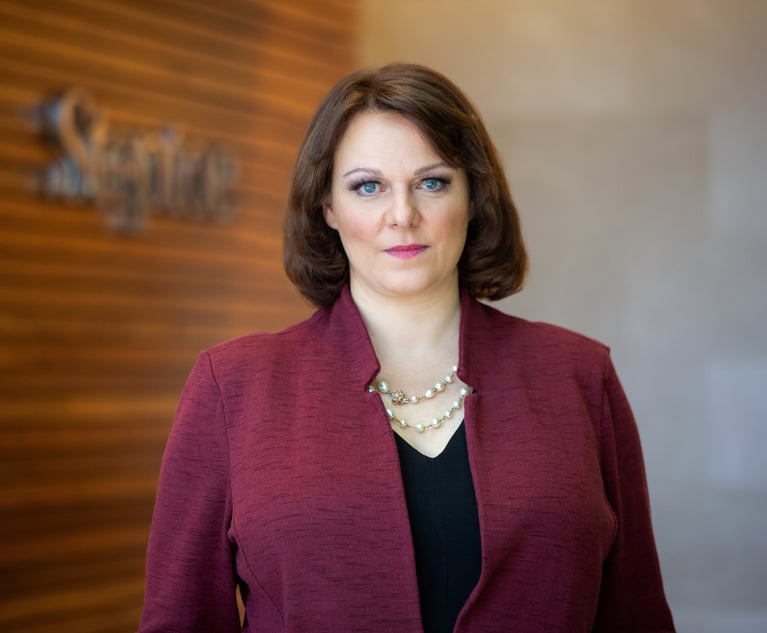Summer Associate Hiring Slowed at Largest Firms
Law firms of 700 or more lawyers pulled back on summer associate hiring for the first time since 2012, according to new data from the National Association for Law Placement.
January 25, 2018 at 03:02 PM
4 minute read

Fewer law students snagged associate jobs at the nation's largest law firms last summer.
New data from the National Association for Law Placement (NALP) shows that firms with more than 700 lawyers scaled back their summer associate classes in 2017—the first decrease since 2012, when large firms started rebuilding the summer associate programs they gutted amid the economic recession.
The average size of the incoming summer associate classes at those large firms last summer was 20, down from 22 in 2016. (Those figures are for each firm office, not the total for each firm.)
“This is a meaningful dip in recruiting at the largest firms,” NALP executive director James Leipold told the law firm recruiters and law school career services personnel assembled in New York Thursday for the the organization's annual recruiting summit, where he revealed the latest figures. “For the last three or four years, we had this bump in Big Law recruiting as they regrew their summer classes. That has ended.”
It's looking like last year's decline in summer associates at the biggest firms will continue into 2018. Those firms extended fewer summer associate offers to incoming second-year law students last fall during the on-campus interview season. The median number of offers fell from 20 in 2016 to 16 in 2017—a 20 percent decrease. The largest number of summer associate offers extended by any firm in 2016 was 565. In 2017, the highest was just 486.
An earlier presentation at the summit by Gretta Rusanow, the head of advisory services at Citi Private Bank's law firms group, offered several possible explanations for the slowdown in summer associate hiring: demand for law firm services has generally remained flat in recent years, with revenue increases coming primarily from rising billing rates. And 88 percent of the law firm leaders recently surveyed by Citi said clients are unwilling to pay for young associates, causing some firms to reduce their rates or simply not charge clients for their work.
Rusanow also noted that some of the work traditionally handled by associates is being shifted to other job categories, including of counsel, non-equity partners, and temporary attorneys.
“The industry has moved away from its dependence on associates,” she said.
The move to $180,000 starting associate salaries at many of the country's largest firms in 2016 could also be a factor in the recent summer associate recruiting slowdown, given that each associate hire now costs firms an additional $20,000 in that first year. (Starting salaries at many of the major firms had stagnated at $160,000 for the better part of a decade before the 2016 increase.) The higher associates salaries also put pressure on firms to raise pay for other non-equity partner positions at firms, Rusanow said.
But the decline in summer associates isn't across the board, NALP found. The average size of 2017 summer programs at all firms was 14—the same as the previous year. The median number of summer associate offers extended last fall by firms of 500 to 700 lawyers decreased modestly from 31.5 to 28, while firms of 250 to 500 lawyers actually increased the median number of offers from 7 to 11.
Overall, 43 percent of firms reported making fewer summer associate offers, while 45 percent reported making more. Another 12 percent said they made no change in the number of offers.
“Some firms have really cut back their summer programs, and some have grown,” Leipold said.
This content has been archived. It is available through our partners, LexisNexis® and Bloomberg Law.
To view this content, please continue to their sites.
Not a Lexis Subscriber?
Subscribe Now
Not a Bloomberg Law Subscriber?
Subscribe Now
NOT FOR REPRINT
© 2025 ALM Global, LLC, All Rights Reserved. Request academic re-use from www.copyright.com. All other uses, submit a request to [email protected]. For more information visit Asset & Logo Licensing.
You Might Like
View All
Orrick Hires Longtime Weil Partner as New Head of Antitrust Litigation


Sidley Adds Ex-DOJ Criminal Division Deputy Leader, Paul Hastings Adds REIT Partner, in Latest DC Hiring
3 minute read
‘High Demand’: Former Trump Admin Lawyers Leverage Connections for Big Law Work, Jobs
4 minute readTrending Stories
- 1Gunderson Dettmer Opens Atlanta Office With 3 Partners From Morris Manning
- 2Decision of the Day: Court Holds Accident with Post Driver Was 'Bizarre Occurrence,' Dismisses Action Brought Under Labor Law §240
- 3Judge Recommends Disbarment for Attorney Who Plotted to Hack Judge's Email, Phone
- 4Two Wilkinson Stekloff Associates Among Victims of DC Plane Crash
- 5Two More Victims Alleged in New Sean Combs Sex Trafficking Indictment
Who Got The Work
J. Brugh Lower of Gibbons has entered an appearance for industrial equipment supplier Devco Corporation in a pending trademark infringement lawsuit. The suit, accusing the defendant of selling knock-off Graco products, was filed Dec. 18 in New Jersey District Court by Rivkin Radler on behalf of Graco Inc. and Graco Minnesota. The case, assigned to U.S. District Judge Zahid N. Quraishi, is 3:24-cv-11294, Graco Inc. et al v. Devco Corporation.
Who Got The Work
Rebecca Maller-Stein and Kent A. Yalowitz of Arnold & Porter Kaye Scholer have entered their appearances for Hanaco Venture Capital and its executives, Lior Prosor and David Frankel, in a pending securities lawsuit. The action, filed on Dec. 24 in New York Southern District Court by Zell, Aron & Co. on behalf of Goldeneye Advisors, accuses the defendants of negligently and fraudulently managing the plaintiff's $1 million investment. The case, assigned to U.S. District Judge Vernon S. Broderick, is 1:24-cv-09918, Goldeneye Advisors, LLC v. Hanaco Venture Capital, Ltd. et al.
Who Got The Work
Attorneys from A&O Shearman has stepped in as defense counsel for Toronto-Dominion Bank and other defendants in a pending securities class action. The suit, filed Dec. 11 in New York Southern District Court by Bleichmar Fonti & Auld, accuses the defendants of concealing the bank's 'pervasive' deficiencies in regards to its compliance with the Bank Secrecy Act and the quality of its anti-money laundering controls. The case, assigned to U.S. District Judge Arun Subramanian, is 1:24-cv-09445, Gonzalez v. The Toronto-Dominion Bank et al.
Who Got The Work
Crown Castle International, a Pennsylvania company providing shared communications infrastructure, has turned to Luke D. Wolf of Gordon Rees Scully Mansukhani to fend off a pending breach-of-contract lawsuit. The court action, filed Nov. 25 in Michigan Eastern District Court by Hooper Hathaway PC on behalf of The Town Residences LLC, accuses Crown Castle of failing to transfer approximately $30,000 in utility payments from T-Mobile in breach of a roof-top lease and assignment agreement. The case, assigned to U.S. District Judge Susan K. Declercq, is 2:24-cv-13131, The Town Residences LLC v. T-Mobile US, Inc. et al.
Who Got The Work
Wilfred P. Coronato and Daniel M. Schwartz of McCarter & English have stepped in as defense counsel to Electrolux Home Products Inc. in a pending product liability lawsuit. The court action, filed Nov. 26 in New York Eastern District Court by Poulos Lopiccolo PC and Nagel Rice LLP on behalf of David Stern, alleges that the defendant's refrigerators’ drawers and shelving repeatedly break and fall apart within months after purchase. The case, assigned to U.S. District Judge Joan M. Azrack, is 2:24-cv-08204, Stern v. Electrolux Home Products, Inc.
Featured Firms
Law Offices of Gary Martin Hays & Associates, P.C.
(470) 294-1674
Law Offices of Mark E. Salomone
(857) 444-6468
Smith & Hassler
(713) 739-1250










